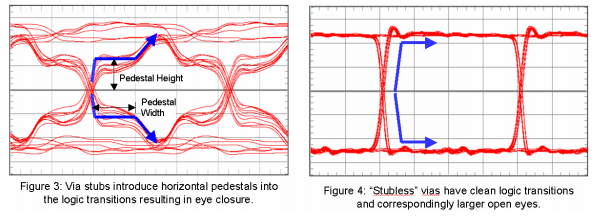Figures 3 and 4 show representative eye-diagrams of two via structures, one with an intact stub and one without a stub.
Comparing Figures 3 and 4, one can see that via stubs introduce horizontal pedestals in the logic 0-to-1 and logic 1-to-0 transitions. These pedestals close the eye, making it more difficult for the digital receiver to ascertain whether the received signal is truly a logical one or a logical zero.
Source: Overview of Backdrilling - Sanmina:
Click image to view
See the link above for the full article.
More about stubs from Altera: High-Speed Board Layout Guidelines.
Daisy Chain Routing With Stubs
Daisy chain routing is a common practice in designing PCBs. One disadvantage of daisy chain routing is that stubs, or short traces, are usually necessary to connect devices to the main bus (see Figure 11–14). If a stub is too long, it will induce transmission line reflections and degrade signal quality.
Therefore, the stub length should not exceed the following conditions:
TDstub < (T10% to 90%) / 3
where TDstub = Electrical delay of the stub
T10% to 90% = Rise or fall time of signal edge
For a 1-ns rise-time edge, the stub length should be less than 0.5 inches
(see the “References” section). If your design uses multiple devices, all
stub lengths should be equal to minimize clock skew.
'via Blog this'

No comments:
Post a Comment